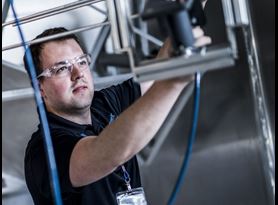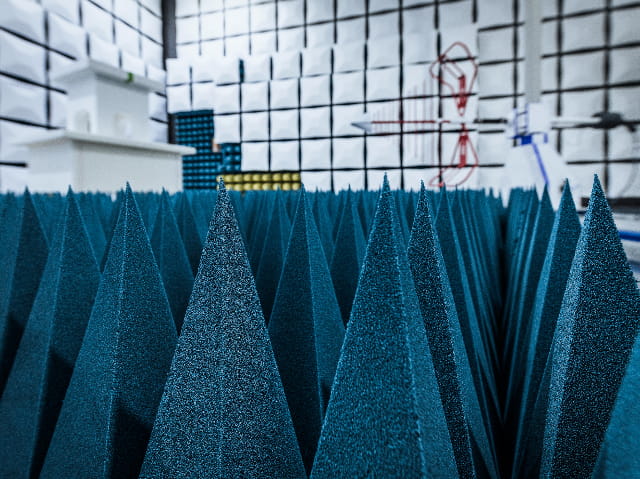Meeting new standards for Medical Electrical Equipment: IEC 60601-1-2:2014+A1:2020 (EN 60601-1-2:2015+A1:2021)

Richard White is a chartered manager with over 13 years of experience in product testing, certification and Global Market Access (GMA).
*Significant technical changes mean manufacturers should review their products now to ensure they are still compliant*
A new version of this standard was released by the IEC 60601-1-2 committee in 2020 (Edition 4.1), replacing the previous edition from 2014 (Edition 4.0). Read this article to learn the main differences between these versions and the key implementation dates in the US (FDA) and EU (European Union).
IEC 60601-1-2 for Medical Electrical Equipment
IEC 60601-1-2 is titled “Medical Electrical Equipment – Part 1-2: General Requirements for Basic Safety and Essential Performance – Collateral Standard: Electromagnetic Disturbances – Requirements and Test” and is the primary EMC standard for medical electrical devices and systems.
IEC 60601-1-2:2014+A1:2020 is the technical equivalent of EN 60601-1-2:2015+1:2021. The EN standard should be applied to a CE declaration of conformity, however, the IEC version of the standard can be used as test evidence to support the declaration.
Environments
Environments of Intended Use have been identified as the Professional Healthcare Facility, Home Healthcare (including nursing homes), and Special. The standard provides clear descriptions of what is considered part of these environments (figure 3 of 60601-1-2:2014+A1:2020), and there is no distinction between life support and non-life support equipment.
Key changes that effect EMC testing in 60601-1-2:2014+A1:2020 (Edition 4.1) / EN 60601-1-2:2015+1:2021
Equipment Under Test (EUT) AC line voltage - In the 2014 version of the EMC standard, only one nominal AC power line voltage and frequency had to be considered for each test, except for Voltage Dips and Interruptions (VDI) which required a minimum and maximum rated voltage.
The 2014+A1:2020 has changed this as now ‘Conducted Disturbance’ (emissions) needs to be done at the minimum and maximum rated voltage, but only if the difference between the maximum and minimum rated input voltage is less than 25% of the highest rated input voltage. As a result of this, most wide ranging power supplies (I.E. rated to work at 100 V to 240 V) will need to have conducted emissions performed twice.
However it should be noted that some countries overrule this and will want all of the EMC testing done at their local supply voltage and frequency regardless.
Proximity to the EUT testing - The 2014 version of 60601-1-2 introduce the requirement for ‘Immunity to proximity field from RF wireless communication’. This test is where the EUT is exposed to spot RF frequencies using pulse modulation to simulate different radio technologies in close proximity to the EUT. The basic levels in the standard are based on a 30 cm minimum separation distance but if the EUT is to be used closer than 30 cm then the test level increases and this has to be documented in the required test plan.
The 2014+A1:2020 version of the standard has taken this a step further and introduced a requirement to do ‘Immunity to proximity magnetic field’ testing in addition to the above ‘Immunity to proximity field from RF wireless communication’. The frequencies applied for ‘Immunity to proximity magnetic field’ testing’ is dependent on the EUT intended environment of use and has to be documented in the test plan.
Conducted disturbance induced by RF fields – The 2014 version of the standard requires conducted immunity testing to be done on signal cables / ports longer than 3 m with a test level of 3 Vrms (6 Vrms for ISM frequencies and amateur radio band frequencies for home health care environments). This test requirement has now changed as the A1:2020 version now requires this test to be applied to signal cables longer than 1 m.
Because of this new requirement to apply the test to cables longer than 1 m, instead of longer than 3 m, it will likely mean that many medical devices that have previously been tested and found compliant to 60601-1-2:2014 will need to have limited re-testing performed on them as it may be that ports / cables were originally excluded for this but are now applicable due to the change in requirements.
Key change summary:
- conducted emission and voltage dips should be tested at minimum and maximum rated voltage
- conducted immunity now applicable to signal input / signal output (SIP/SOP) on cables greater than 1m
- Introduction of new test requirements ‘Immunity to proximity to magnetic fields test’
Test Plan and Risk Management
Before the start of formal testing, a detailed test plan must be provided to the test laboratory. The test plan must be written with an understanding of the possible effects of EMC phenomena on the device and how it can affect the device's basic safety and essential performance. Any deviations from the test plan must be documented in the test report, which should follow the guidance outlined in Annex G of IEC 60601-1-2:2014+A1:2020.
A shortened version of the required details are:
- Description of Equipment under Test
- Documentation of the risk management approach
- Basic safety and essential performance required for the (EUT)
- Monitoring methods of basic safety and essential performance during and after EMC phenomenon application
- Environment of use and from this, test levels / limits to be applied for each EMC test and port on the EUT
- Consideration of the proximity to radio technologies
- Clear setup / configuration of the device and operating modes to be tested in (there may be several configuration and operating modes required to correctly capture all the basic safety and essential performance highlights in the risk management)
- Justification for any tests being excluded
- Earthing arrangement
- Use of simulators, artificial hands and auxiliary equipment to exercise the EUT
- Dwell time for each immunity test (can be affected by operating cycle of the device and essential performance requirements)
IEC 60601-1-2 Implementation Dates
United States (FDA) – FDA recognition of IEC 60601-1-2 Edition 4.0 2014 will be superseded by recognition of IEC 60601-1-2 Edition 4.1 2020. FDA will accept declarations of conformity, in support of premarket submissions, until December 17th, 2023. After this transition period, declarations of conformity will not be accepted.
European Union (EU) – Recognition of EN 60601-1-2:2015 (the technical equivalent of IEC 60601-1-2:2014) will be superseded by recognition of EN 60601-1-2:2015+1:2021 (the technical equivalent of IEC 60601-1-2:2014+A1:2020) on 19th March 2024. After this transition period the IEC 2014+A1:2020 (EN 2015+A1:2021) will need to be used.
Element offers testing and certification services to help you meet global product safety standards set by the IEC 60601 series.
For more information about our IEC 60601 Medical Device Safety Testing services, or to request a quote, contact us today.
Find related Resources
More From Element

Advisory Services
Our team of Engaged Experts can help you understand the various regulatory requirements and reduce the test burden by comparing the various standards and producing compliance strategies that fulfill the brief of ‘test once, approve to many’.

IEC/EN 61010-1: Electrical Laboratory Equipment Testing
Element provides testing services to IEC/EN 61010-1, ensuring that your electrical measurement, control, and laboratory products are safe, compliant, and get to global markets faster.

Wireless Coexistence Testing for Medical Devices
As more wireless medical devices enter the product development cycle, wireless coexistence testing is one of the many recommended tests that provides pertinent information for regulatory submissions.

Test Protocol for Medical Devices
A protocol and plan will mitigate your risk, prevent confusion, set clear expectations, and preserve the necessary information for future reference and use.

